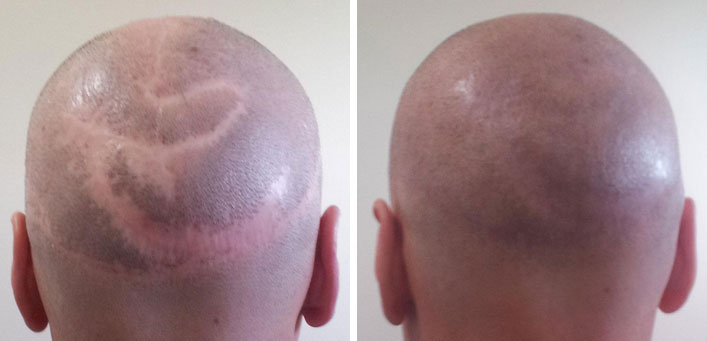Here we explain the factors that most influence the level of scar concealment achieved
Scalp micropigmentation is commonly used to effectively camouflage all sorts of scars, but first and foremost we treat hair transplant scars. These are the most common, and take many forms from strip scars at the back or side of the head, to dotted FUE scars caused by follicular unit extraction surgery in both the donor and recipient areas.
For the purposes of this post, I’m going to focus on strip and scalp reduction scars. For more information about FUE, see this post.
The size of the scar
Clearly larger scars require more work to conceal than smaller scars, however the overall level of camouflage is not affected as much as you may think by the size of the scar area.

The client above was left with horrific scars following a scalp reduction procedure, however the size of the scar caused no real issues in terms of the final result achieved.
The texture of the scar
Although the role is a minor one, the texture of the scar does play a part. Ideally scars are of a similar texture to the surrounding skin. Very soft scars tend to absorb pigment more readily and often need more treatment sessions to complete the camouflage. Generally older scars are more predictable, although new scars are treated all the time as long as the wound has healed sufficiently.

The colour of the scar
For an effective camouflage to take place, the colour of the scar should be as close to the colour of surrounding skin as possible. Any scars that are still red are a real problem, although light pink scars can be treated. Men with dark skin often find that a greater variation between their scar and skin colour is seen, so we advise any men who believe this to be their situation to contact us for specific advice.
White scars, usually older scars on caucasian men, are often lighter than the surrounding skin. This does not usually present any problem in terms of concealment.
The indentation or protrusion of the scar
This is possibly the biggest factor that determines the level of camouflage achieved. Scars are rarely completely flat. Most are raised (protruding) slightly, and some are indented.
If your scar is slightly raised or slightly indented, there is usually no cause for concern. If however the difference versus the surrounding skin is significant, there are pre-treatments available that can significantly improve the final outcome. These include Fraxel laser, Vbeam laser and dermal fillers.
Scars are highly individual and are assessed on a case by case basis. More information can be found here. To send us photos of your scar/s for a free assessment, please contact us.
